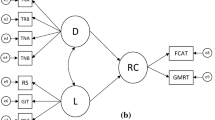Abstract
The prereading and reading performance of a group of 370 predominantly Hispanic, bilingual public school children was followed for six years. The aim of the study was to compare the factorial make-up and predictive validity of tests used in the current research with findings from a previous study. The early study had followed the children from the end of their kindergarten year until the end of second grade. For purposes of the present study a 13-test predictor battery was administered to the children at the beginning of their first-grade year. This battery included a number of measures used in the early study, among them a 5-test Screening Index developed in the course of that study. Records were obtained of the follow-up children’s 2nd, 3rd, 4th, 5th, and 6th grade reading test scores. Factor analysis of the pool of 13 predictor tests showed a two-cluster battery structure. These clusters closely resembled two of the four factors defined in the early study. As used with the group of bilingual children, the Screening Index misclassified many of the failing readers, as well as others who went ahead to read at grade level. The Screening Index quite accurately identified, across grades, children who eventually read well. A number of predictor tests administered at beginning of first grade continued to show significant correlations with reading at all grade levels. The consistent contribution of the predictor tests with reading points to their continuing usefulness as a point of departure for assessing children’s readiness to read.
Similar content being viewed by others
References
Badian, N. 1982. The prediction of good and poor reading before kindergarten entry.Journal of Special Education 16:309–318.
Badian, N. 1986. Improving the prediction of reading for the individual child: A four-year follow-up.Journal of Learning Disabilities 19:262–269.
Badian, N. 1988a. The prediction of good and poor reading before kindergarten entry: A nine-year follow-up.Journal of Learning Disabilities 21:98–103.
Badian, N. 1988b. Predicting dyslexia in a preschool population.In R. Masland and M. Masland (eds.)Pre-School Prevention of Reading Failure. Parkton, Maryland: York Press.
Benton, A. 1959.Right-Left Discrimination and Finger Localization: Development and Pathology. New York: Hoeber-Harper.
Bradley, L. 1988. Rhyme recognition and reading and spelling.In R. Masland and M. Masland (eds.)Pre-School Prevention of Reading Failure. Parkton, Maryland: York Press.
Defries, J. and Baker, L. 1983. Colorado family reading study: Longitudinal analysis.Annals of Dyslexia 33:153–162.
de Hirsch, K. 1957. Tests designed to discover potential reading difficulties at the six-year-old level.American Journal of Orthopsychiatry 27:566–675.
de Hirsch, K., Jansky, J., and Langford, W. 1966.Predicting Reading Failure. New York: Harper and Row Publishers.
Denckla, M. and Rudel, R. 1976. Rapid “automatized” naming (R.A.N.): Dyslexia differentiated from other learning disabilities.Neuropsychologia 14:471–479.
Hogg, R. and Craig, A. 1978.Introduction to Mathematical Statistics. 4th ed. New York: Macmillan Publishing Company, Incorporated.
Horn, W. and O’Donnell, J. 1984. Early identification of Learning disabilities: A comparison of two methods.Journal of Educational Psychology 76:1106–1118.
Jansky, J. 1970. The contribution of certain kindergarten abilities to second grade reading and spelling achievement. Ph.D. Thesis. Columbia University.
Jansky, J. and de Hirsch, K. 1972.Preventing Reading Failure. New York: Harper and Row Publishers.
Keogh, B. and Daley, S. 1983. Early identification: One component of comprehensive services for at-risk children.Topics in Early Childhood Special Education 3:7–16.
Keogh, R., Sears, S., and Royal, N. 1988. Slingerland screening and instructional approaches for children at-risk for school.In R. Masland and M. Masland (eds.)Pre-School Prevention of Reading Failure. Parkton, Maryland: York Press.
Liberman, I. 1973. Segmentation of the spoken word and reading acquisition.Bulletin of the Orton Dyslexia Society 23:65–77.
Miller, J. and McKenna, M. 1981. Disabled readers: Their intellectual and perceptual capacities at differing ages.Perceptual and Motor Skills 52:467–472.
Monroe, M. 1935. Reading aptitude tests for the prediction of success and failure in beginning reading.Education 56:7–14.
Morrison, D. and Hinshaw, S. 1988. The relationship between neuropsychological/perceptual performance and socioeconomic status in children with learning disabilities.Journal of Learning Disabilities 21:124–128.
Morrison, D., Mantzicopoulos, P., and Stone, E. 1988. Screening for reading problems: The utility of SEARCH.Annals of Dyslexia 38:181–192.
Orton, S. 1937.Reading, Writing and Speech Problems in Children. New York: W. W. Norton and Company.
Rutter, M. and Yule, W. 1975. The concept of specific reading retardation.Journal of Child Psychology and Psychiatry 16:181–197.
Satz, P. and Fletcher, J. 1982.The Florida Kindergarten Screening Battery. Odessa, Florida: Psychological Assessment Resources, Incorporated.
Schaer, H. and Crump, W. 1976. Teacher involvement and early identification of children with learning disabilities.Journal of Learning Disabilities 9:91–95.
Silver, A., Hagin, R., and Beecher, R. 1978. Scanning, diagnosis, and intervention in the prevention of reading disabilities.Journal of Learning Disabilities 7:437–449.
Simmer, M. 1983. The warning signs of school failure: An updated profile of the at-risk kindergarten child.Topics in Early Childhood Special Education 3:17–26.
Stanovich, K. 1980. Toward an interactive compensatory model of individual differences in the development of reading fluency.Reading Research Quarterly 16:32–71.
Vellutino, F. 1987. Dyslexia.Scientific American 256:34–41.
Author information
Authors and Affiliations
Additional information
The investigation was conducted by the staff of the de Hirsch-Robinson Reading Clinic, Department of Pediatric Psychiatry, Columbia-Presbyterian Medical Center, and the New York State Psychiatric Institute.
The work has been supported by generous grants from a number of private donors, among them The Beinecke Foundation, The Morgan Family Fund, The Lita Annenberg-Hazen Charitable Trust, Mr. Seymour Milstein of the Milstein Family Foundation, and Mrs. William Carey.
Rights and permissions
About this article
Cite this article
Jansky, J.J., Hoffman, M.J., Layton, J. et al. Prediction: A six-year follow-up. Annals of Dyslexia 39, 227–246 (1989). https://doi.org/10.1007/BF02656911
Issue Date:
DOI: https://doi.org/10.1007/BF02656911




